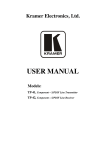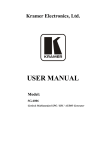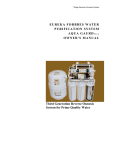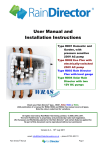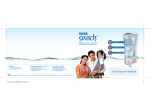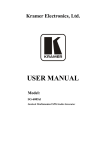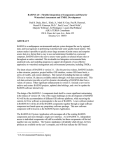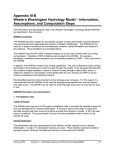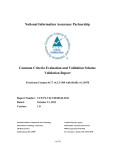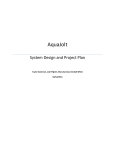Download User Manual and Technical Specifications
Transcript
by ADL PRODUCTS User Manual and Technical Specifications Version 1.11 issued for beta testing 9th October 2008 All rights reserved by ADL Products, © 2008. The term RainDirector is proprietary and protected by trade mark legislation. UK, European and Worldwide patents for the RainDirector and certain features applied for. No part of this document can be reproduced without our permission R.Lester, A.Lester, M.Bicknell [email protected] Rain Director® Specs Oct 2008 - phone 01733 405100 Page 1 1) Overview The Rain Director® is designed to optimise the water flow from a rainwater harvesting system to toilets, washing machine and the garden in a typical house. Its intelligent tank (in the roof space), control panel (at ground level) and electric pump (submerged in the rain harvesting tank) provide water supply under gravity wherever it’s needed while reducing power consumption, reducing pump wear and ensuring crystal clear water at all times. The Rain Director® enables sufficient rainwater to be stored in a header tank (cutaway diagram, above right) to meet the daily needs of a household’s toilet cisterns and washing machines, without continually running pumps. The Rain Director® allows all the water in the header tank to be used before refilling, which therefore avoids the cost of electricity1, pump strain and pump wear due to pumping water every time a small amount is used. The Rain Director® allows the household to use as much rainwater as needed and reduces the amount of mains water used to a minimum. It also makes mains water available in the event of a long drought and an empty rain water tank. While normal function requires no user input, the control panel (picture, right) provides certain functions at the push of a button, needed from time to time. Backup systems ensure fail safe operation and continuity of supply. The comparative table in section 9 below shows the advantages over existing solutions on the market. 1 Note that an electric pump uses a disproportionately high amount of electric power (a “surge”) every time it starts up. The Rain Director’s pump starts up about 10 times less often than those in other systems which have to start every time a toilet is flushed or when pressure in the pipe subsides. Rain Director® Specs Oct 2008 Page 2 2) Controls There are no user controls in the roof-space header tank supplied with the Rain Director. Two float sensors register the upper and lower water levels within the tank and inform the programme logic in the control panel. A float switch (ball cock) prevents mains water overfilling the tank in the event of a power cut or malfunction. The control panel with its water valves can be located on a wall in a visible place in a utility room on the ground floor or where convenient. Four “push button” switches on the right of the control panel are; “Normal” “Mains water only” “Holiday” “Flush” The switches are connected to a programmable logic controller (PLC) in the control box, which stores the Rain Director’s computer programs and converts the inputs to useable outputs controlling the water flow. Three physical outputs, powered from a 12v A.C. supply by the controller, turn on and off the three solenoid water valves in the housing to the left of the control panel. A fourth water valve, the mains water bypass, is to the left of the others, and can only be turned on and off manually. This maintains a supply if there is no rainwater left and there is a power cut. Rain Director® Specs Oct 2008 Page 3 3) Operation & indicator lights 2 level sensors in the header tank provide data to the computer built in to the control panel which then controls 3 electrically operated water valves alongside: • The rainwater solenoid valve controls the inflow of pumped water from a 240 volt pressure-sensitive demand pump in the underground rain water storage tank. When the valve opens, the pump registers the drop in pressure and supplies water to the header tank until a “tank full” signal closes the valve. • The mains solenoid valve is connected to the mains water supply. This is used mainly as a back up water supply if the rainwater should run out. • The flush valve can be opened by the system to let water out at any time. • In the event of a power supply failure a mains bypass can be opened manually and the tank will fill with mains water until the conventional ball cock closes (3.9 below). The LED lights on the left of the control panel indicate the status of the system: Rain filling A demand has been made on water supply from the header tank so rain water is flowing normally into the header tank. Mains filling Mains water is flowing into the header tank, either because the rain water tank is empty or the user has directed it to do so Mains water only “Mains water only” button has been pressed, typically to save rain water. Press “Normal” to revert to normal operation. Holiday mode Flush mode Mains water not working (red) Power On Rain Director® Specs Oct 2008 The “Holiday” button has been pressed. The header tank has emptied its rain water and filled up with mains water. This is to avoid the rainwater getting brackish in the header tank. You may flush toilets with mains water before leaving the house. Existing water in the header has been discarded and new rain water is flowing into the header – either because user has pressed “Flush” or because “Auto Tank Refresh” mode has been triggered by timer and conditions. Rain Director has also detected that the mains water is not flowing; this could be due to the home’s mains stopcock being turned off, major leak or some other mains water failure. Investigate cause immediately. Rain Director has been turned on and is under main electric power. Stays on during normal use. Flashes during “Set Up” mode. Page 4 3.1 Normal Running During normal use the Rain Director® control system monitors and maintains the availability of rainwater in the tank. The Power On indicator light is on. The Rain filling light flashes when rain water is being pumped into the header tank. Should the rainwater run out or become otherwise unavailable, the system automatically switches to mains water and the Mains filling light begins flashing. In exceptional circumstances, the Rain Directors’ mode is changed automatically using the control panel buttons, as follows. 3.2 Set-up Mode (lasts several hours) Flashing The set-up (or “commissioning” mode) is used once after installing when the user or installing engineer press both the flush and holiday buttons at the same time. This process automatically calibrates the flow timers and stores in memory the time it takes for the rain water to fill the tank and for the mains water to fill the tank. At any time thereafter, if the top sensor fails, the tank fills with rain water (if available) or mains water according to the time intervals memorised. The reason why the time intervals have to be calibrated for each Rain Director® installation is because different sized header tanks, different water pressures and other variables make it impossible to establish the fill times as a factory setting. Calibration of the flow timers by set-up mode only needs to be completed once in the system’s lifetime unless a new header tank or pump is fitted. During the set-up process the Power On light flashes. The tank fills with rainwater, flushes, fills with mains water and flushes… then repeats the process two more times. The computer takes the average of the fill time for rainwater and for mains water and stores these two values. During these cycles, you will see the Rain Filling, Mains filling and Flush indicator lights come on and off. The set-up may therefore take several hours. You can interrupt the process if absolutely necessary but you would have to run it again to complete the installation. 3.3 Auto Tank Refresh If the water in the header tank is not used in a 3-day period, the refresh program automatically flushes out the system, emptying the header tank back into the underground tank. The header then refills with fresh rainwater. This feature is disabled when the holiday mode is running. If the house is left empty, and the holiday button is not pressed, the Rain Director® automatically refreshes the system every 3 days. The purpose of refresh is to prevent rainwater in the header tank (which in a roof space in summer could be Rain Director® Specs Oct 2008 Page 5 at 20°C or higher) from getting brackish; cool clear water from the underground tank (at about 5°C or less) is pumped into the header. 3.4 Flush Mode The flush mode allows the rainwater in the header tank to be changed by pressing the flush button on the panel. When the valve is opened the water will flush out and is directed back into the rainwater-harvesting tank. This might be triggered if little water has been used and the ambient temperature is high; this gives the user the choice to avoid brackishness by replacing the water in the header tank. This is the same as Auto Tank Refresh but triggered manually. 3.5 Holiday Mode The holiday mode empties the header tank and then refills with mains water. Remember to press the holiday button a few hours in advance of leaving. Providing the header tank has had time to fill with mains water and providing you flush the toilets twice after pressing the holiday button, the toilet cisterns and bowls are filled with chlorinated water that stays fresh for however long the duration of the holiday. On return from holiday all toilets and washing machines will be available as normal and the Rain Director® system will then automatically revert to normal mode. 3.6 Mains Water Only Mode Once the mains water only button is pressed, the system selects mains water to fill the header tank. The existing water in the header tank is used as usual but is replenished with mains water. This method of operation continues until the normal button is selected. This mains water only feature is provided to enable the rain water to be conserved for garden use during a drought. The same pump submerged in the rain storage tank can still be used at that time provided that its output is equipped with a T joint feeding a tap or other garden outlet. Alternatively a second pump for garden use only can be out in the rain storage tank. 3.7 In the event of power cut 3.8 Time Limit Flow Mode – upper sensor failure In the event of a mains electricity power cut, firstly, water in Off the header tank flows by gravity as required until it runs out. Secondly, thereafter, the mains water supply valve can be manually opened and the tank will fill with mains water until the conventional ball cock closes; see instructions in Manual mains water bypass in 3.9 below. This valve will require closing after the power is restored. In the unlikely event of a failure of the UPPER float sensor in the header tank the Rain Director® tries to fill the header tank, establishes that the upper sensor has not given a “full” signal, and “times out”. The Main water not working light illuminates. Rain Director® then switches to its back up program which fills the tank according to the flow time stored in memory. Please also read the note on Set-Up mode in 3.2 above. The warning light Rain Director® Specs Oct 2008 Page 6 indicates that the sensor most likely needs changing (unless both rain and mains water had run out). 3.9 Manual mains water bypass – lower sensor failure In the unlikely event of a failure of the LOWER float sensor in the header tank, Rain Director® will not know that the tank is empty. Water will be not available neither at toilets, washing machine or other appliances feed with rainwater. No indicator light shows. To reinstate water supply, remove the cover surrounding the control panel and water valves. Select the manual (non electric) valve to the far left (blue in the picture, right, of the control panel without its cover) and turn it 90 degrees to open the mains flow. 1 Electric power to the other valves is 12 volt only so there is no risk of 2 electric shock. Mains water flows 3 into the header tank until the ball cock valve turns the flow off. This safety feature works even if there is no electric power to the system. Call your installer or supplier to confirm the fault and replace the part. 3.10 Overflow tower – multiple failures The overflow tower in the header tank is a large, open-topped, watertight cylinder whose top is below the top of the tank. If all other systems were to fail, and rain or mains water is flowing unchecked into the header tank, the excess water flows over the top of the cylinder and out of the 40mm overflow pipe. The large diameter overflow tower provides the head and the impulsion to ensure high volume flow through the overflow pipe, thus reducing to a minimum the risk of any overflow over the top edges of the tank itself into the roof space. 3.11 Garden Use and optional smaller pump types The Rain Director is optimised for supply of rainwater to toilets and washing machine in the house, but the stored rainwater can of course also be used for watering the garden, washing the car and other outdoor uses. For this reason The Rain Director is supplied with a 1100 watt pressure-sensitive pump; it’s perfect for long term domestic use but can also supply rainwater to a hose as required. The outlet to the garden can be plumbed at any point in the pipe between the pump and the header tank, so it will get the full power of the pump. If it’s plumbed after the header tank then that outlet will only get gravity feed. If your system is not going to supply an outdoor tap, then a smaller pump, using less electrical power, can be fitted with The Rain Director. Enquire at RainWaterHarvesting.co.uk or your supplier for suitable types. Rain Director® Specs Oct 2008 Page 7 4. The header tank The rain water supply pipe (A) is routed to the bottom of the tank, in order to reduce turbulence or splash. The mains supply (B) is at a lower pressure and, to provide the air gap required by U.K. building regulations, it flows into the tank from above the surface of the water. Mains flow is solenoid controlled. The ball cock valve (C) prevents overflow of the mains water flow even when there is no power. B A C Cutaway view of smart header tank E D D G F The supply of water to the tank is governed by two level sensors at the top and bottom of the tank (D). The overflow tower (E) is a large, open-topped, watertight cylinder whose top is below the top of the tank. If all other systems were to fail, water flows over the top of the cylinder and out of the 40mm overflow pipe (F). The large diameter overflow tower provides the head and the impulsion to ensure high volume flow through the overflow pipe, thus reducing to a minimum the risk of any overflow over the top edges of the tank itself into the roof space. B C D E A Side view of components of the smart header tank D F G The feed pipe (G) takes water from the tank to be used around the house. It is suitable for compression-fit 22mm copper or plastic variant piping. The following 5 diagrams show the smart header tank in cutaway view in different phases of function. Rain Director® Specs Oct 2008 Page 8 4.1 Tank is empty Lower sensor is down. Rain Director® knows tank is empty. Control box orders tank to fill with rainwater if available. 4.2 Rain filling Control box has sensed there is rainwater available and has ordered tank to fill with rainwater. 4.3 Rain full Upper sensor has been raised by water. Control box sensed there was rainwater available and has filled with rainwater. 4.4 Mains filling Control box has sensed there is no more rainwater and has ordered tank to fill with mains water. 4.5 Mains full Float valve has been raised by water. Control box knows tank is full and has turned off mains water input. Rain Director® Specs Oct 2008 Page 9 5) Installation These instructions assume that a rainwater harvesting tank has been installed on the premises. See also page 13 for a schematic diagram. 1 2 3 5.1 Pump 5.1.1 Lower the rainwater pump into the rainwater storage tank with a cord and secure the top of the cord to the turret of the tank to enable the pump to be pulled out again for maintenance. 5.1.2 Connect the pump’s cable to a permanent 240 volt AC supply which should be turned on at the time the control panel is switched on. 5.1.3 Connect the optional floating intake to the input of the pump 5.1.4 Connect the rainwater supply from the output of the pump in the underground storage tank to the bottom of the middle valve (2 above), and the top of the valve to the header tank at (A). 5.2 Header Tank 5.2.1 Install the header tank in the roof space with anti-freeze lagging as with any tank. 5.3 Control Panel 5.3.1 Mount the control panel to the wall in a utility room or where mains water is available 5.3.2 Ensure control panel is within reach of available 240 volt AC mains socket. 5.3.3 Connect 3 core signal wires between the control panel and the header tank. 5.4 Piping (Schematic diagram can be found on page 13) 5.4.1 Connect domestic feed pipe network (typically compression-fit 22mm copper or plastic variant piping) to header tank at (G), the low level plain outlet. 5.4.2 Connect 40mm overflow pipe to header tank at (F), the outlet from the 100mm overflow tower. Do not reduce the diameter of this pipe and ensure it runs downhill. 5.4.3 Connect mains water supply to the bottom of the left hand valve in the control panel (1 above), and from the top of the valve to the header tank at (B). 5.4.4 Connect the bottom of the right hand “flush” valve (3 above) to a drain or, preferably, the underground rainwater storage tank, and the top of the valve to a suitable low-lying part of the internal gravity-fed rainwater supply piping. 5.5 Commissioning 5.5.1 Turn on the 240 volt AC supply to the control panel. 5.5.2 Press the bottom two buttons on the control panel to enter set-up mode (see 3.2 on page 5) which can take several hours to run. See 3.2 above. Check for leaks at control panel and at header tank, after which the set up mode need not be attended. 5.5.3 Check later that set up has completed and that normal mode is selected. Rain Director® Specs Oct 2008 Page 10 6) Power Consumption Using RainDirector® During tests on a 114-litre header tank we found the power consumption to be around 0.06 Kwh (0.06 units on a household meter) per pump cycle (filling the tank from empty). Pump run on demand, existing rain systems Consumption with a classic system (not using a RainDirector®) can be 1100w running every time the toilet flushes plus start-up surges. 7) Safety Features The system has many inbuilt safety features 7.1 Float Sensors The float switches are the first barriers to flood. They turn off the rain or mains water supply when the header tank is full. 7.2 Time Limit Flow control Should the upper sensor fail, the control panel uses time limit flow control. The timing values used are those calibrated for this particular system during setup. 7.3 Ball Cock Valve This valve limits the mains water level in the header tank even if there is a power cut. 7.4 Overflow Tower A 4” (100 mm) diameter drain is designed to absorb the combined flow of both the rain and mains water feeds if they were left on by the unlikely event of significant equipment failure. The large diameter overflow tower provides the head and the impulsion to ensure high volume flow through the overflow pipe, thus reducing to a minimum the risk of any overflow over the top edges of the tank itself into the roof space. With this feature in place, all the water delivered to the header tank harmlessly flows out of the house, into the guttering and back in to the rainwater tank. Rain Director® Specs Oct 2008 Page 11 8) Schematic Colour key Rain Water Supply Mains Water Supply Water Used In The House Overflow Water Flushed Water Header Tank Rainwater to tank 22 mm Domestic 22 mm feed 40 mm over flow pipe into guttering 3 core 0.75 mm signal wires 15mm flush pipe connected to main supply 240 v mains Control Panel Rainwater to control panel 25mm (1”) Pump Rainwater Tank Rain Director® Specs Oct 2008 15 mm mains water pipe Water is drawn from the rainwater tank to fill the header tank. If needed mains water can be used to help fill the tank. The water is then used around the house in various appliances such as toilets and washing machines. The flush system is drawn from a low lying part of the rainwater feed piping. Any water that has overflowed or is flushed runs out of the house and back into the rainwater tank. Page 12 9) Comparisons, advantages The rainwater harvesting marketing serves many different applications, from domestic dwellings to market gardeners, schools, institutions and light industry. The layout of the system varies by application and by manufacturer. This comparison chart shows typical rainwater harvesting layouts and the advantages of the Rain Director® … Rain Director® Existing product Ground level2 storage tank and submerged pump Ground level storage tank with mains backup by float switch and solenoid valve or by Rain Manager or similar. Roof space header tank without Rain Director® 2 1. Pump starts every time water is used. 2. Loss of pipe pressure makes pump cycle even when water is not being used. 3. Turning water flow off from appliances puts strain on the pump 4. No rainwater available during power cut 5. No water available if rain water runs out 1. Pump starts every time water is used. 2. Loss of pipe pressure makes pump cycle even when water is not being used. 3. Turning water flow off from appliances puts strain on the pump 4. No rainwater available during power cut 1. Pump starts every time water is used. 2. Loss of pipe pressure makes pump cycle even when water is not being used. 3. Header tank float valves turning off put strain on the pump 4. Float switch failure can cause flooding of water from the overflowing header tank 1. Pump only starts when header tank has emptied. Less stop start pumping. Less hunting, Less strain on pump. Less power used. 2. Pump is controlled by Rain Director not pressure switch. Less hunting. Less strain on pump. Less sustained pressure in pipes so less likelihood of leaks. 3. As in 2 above 4. Water in header tank is available. 5. Mains water switches in automatically 1. Pump only starts when header tank has emptied. Less stop start pumping. Less hunting, Less strain on pump. Less power used. 2. Pump is controlled by Rain Director not pressure switch. Less hunting. Less strain on pump. Less sustained pressure in pipes so less likelihood of leaks. 3. As in 2 above 4. Water in header tank is available. 1. Pump only starts when header tank has emptied. Less stop start pumping. Less hunting, Less strain on pump. Less power used. 2. Pump is controlled by Rain Director not pressure switch. Less hunting. Less strain on pump. Less sustained pressure in pipes so less likelihood of leaks. 3. As in 2 above 4. Overflow tower ensures excess water to header tank flows away safely. Ground level includes submerged rainwater storage tank Rain Director® Specs Oct 2008 Page 13 10) Component parts 1. Header Tank. 114 litre open top rectangular water tank (K25R) to act as the header tank. a. 2 X float sensors to give an input to the programmable logic controller. b. 1 X 100mm inner diameter water pipe with blanking plug to act as overflow tower c. Dimensions: 736mm (L) X 584mm (W) X 533mm (H). The header tank is designed for installation in the roof space. Allow space at the rear (mains and rainwater input pipes) and at the front (rainwater output and overflow output pipes). Picture on page 2 above. 2. Control Panel, including a. 3 X 1/2” normally closed male mini Series Solenoid Valves (7202NC) with 12v A.C. electrical connections to control the valves running the mains supply, rainwater supply and flush. b. 1 X manual valve attached to the mains water supply to enable manual mains water bypass. c. 1 X dedicated logic controller (PLC). d. 4 X generic system control buttons. e. 7 X generic LED indicator lights f. Dimensions: 325mm (W) X 260mm* (H) X 95mm (D) (D = depth front to back). The control panel is designed for wall mounting in a utility room or where it’s located. * Space should be available above the panel and below the panel for the input and output pipes. The fittings protrude about 100mm above and below the control panel housing, so the overall vertical wall space required is about 460mm. Picture of the control panel without its cover on page 7 above 3. Pump. 1 X Automatic, pressure sensitive 1100 watt, 11.5kg 1hp pump to pump water from the rainwater storage tank. Rain Director® Specs Oct 2008 Page 14 11) Washing machines Some modern washing machines require a higher pressure of water than older machines. Manufacturer’s spec often states 1 to 1.5 bar. This is because the washing machine’s controller measures the times time taken for the water to fill the washing machine and times out if it is not fast enough. In the case of Miele, Electrolux, AEG, Zanussi and Tricity washing machines, the manufacturers recommend you ensure that the header tank is at least 16.5 feet above the washing machine. This problem can occur in any home with a header tank, not just with RainDirector®. However, in the documented experiences, most machines work with 0.5 bar or less, and it is likely that you will have no issues. If you cannot get the header tank as high as that, fit up the piping and see if the washing machine works satisfactorily. If not, here are some remedies. 1) Ensure the piping from the header tank to the washing machine is as wide as possible and has no constrictions at the joins. 2) Have the pressure-reducing spiral at the water input of the washing machine removed (n.b. check whether this invalidates your washing machine guarantee) 3) Failing which, fit a pressure sensitive booster pump at the rain output of the header tank or before the water input of the washing machine. Such a pump is available from tool catalogue retailers and from you RainDirector® stockist www.RainWaterHarvesting.co.uk . 12) Guarantee All components and the ensemble guaranteed by the manufacturer ADL Products for one year from the date of purchase. All rights reserved by ADL Products, © 2008. The term RainDirector is proprietary and protected by trade mark legislation. UK, European and Worldwide patents for the RainDirector and certain features applied for. No part of this document can be reproduced without our permission R.Lester, A.Lester, M.Bicknell [email protected] Rain Director® Specs Oct 2008 - phone 01733 405100 Page 15
















